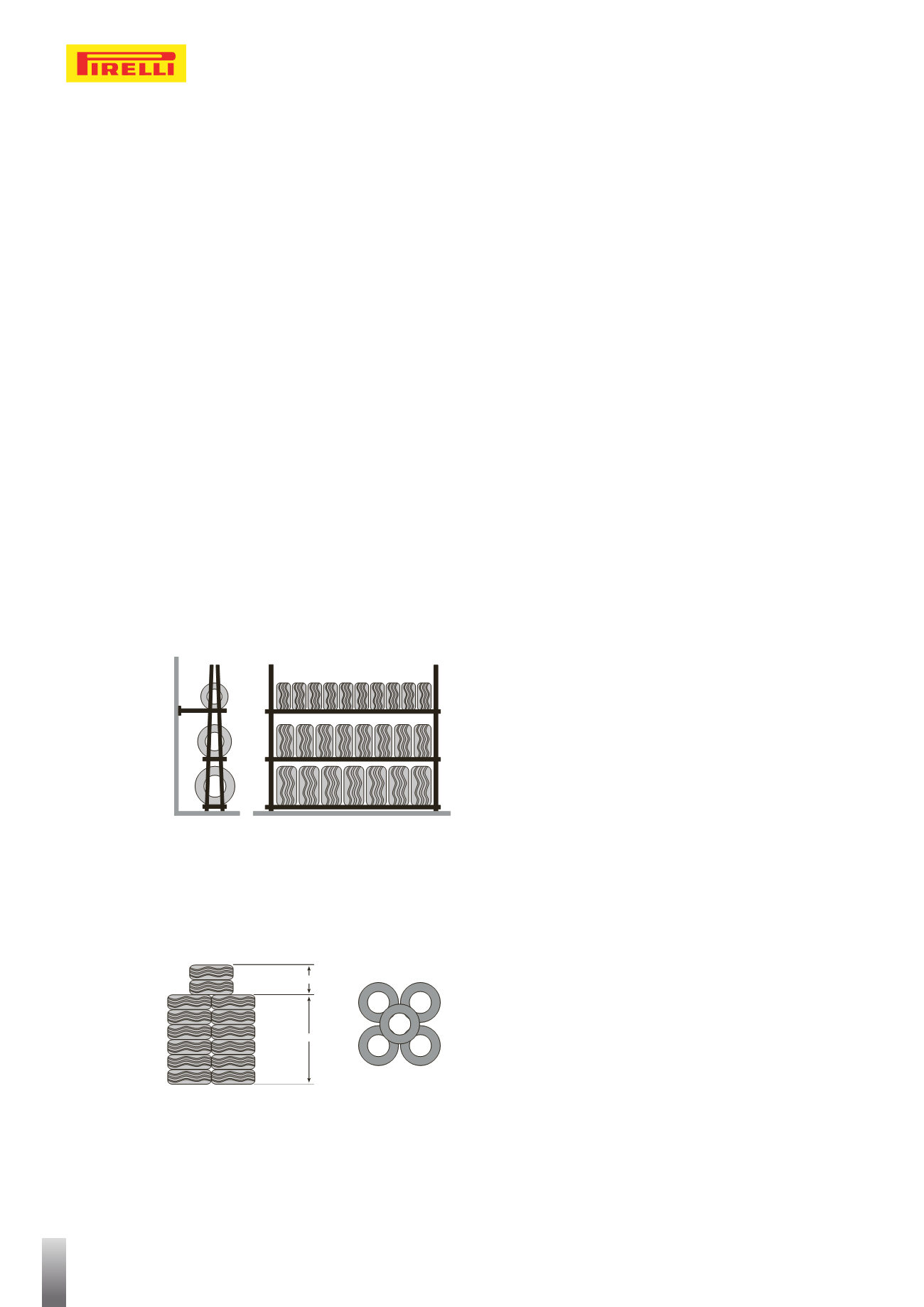

230
STORAGE INSTRUCTION
RECEIPT OF TYRES – AREA OF CONSERVATION
In bad weather conditions, unloading at the time of receipt must be carried out in a covered area; in any
event, if water is found inside the tyres, this must be removed immediately.
Unloading must not be carried out by dropping the tyres or by any other method which could damage
the quality or visual aspect of the tyres. Tyres must not be moved by inserting the forks of a fork lift truck
through the center of a tyre which could damage the bead area.
Tyres must be stored inside a clean, dry and ventilated area, protected from direct sunlight or other
source of artificial light (illumination must be realized with lamps of low ultraviolet and infrared emission).
In the case of temporary external storage, the tyres must be covered (eg. with an impermeable opaque
material) and protected from contact with water and humidity.
TEMPERATURE
The storage temperature must be less than 35°C and preferably less than 25°C. A temperature greater
than 50°C, especially if stock rotation is not sufficient, can result in accelerated forms of deterioration,
such as to reduce the duration in use of the tyre. Avoid contact with heaters and radiators. Very low
temperatures in the storage area are not in themselves damaging, but can provoke rigidity of the tyre.
In this case, they must not be deformed during movement or fitting. If they are destined to be used
immediately they are released from storage, it is necessary to keep them for a few hours in an area with
a temperature of approximately 20°C.
OXYGEN, OZONE AND CHEMICAL SUBSTANCES
Appliances which generate ozone must not be introduced into the storage area, also gas and vapors from
combustion which can generate ozone via photo-chemical processes must be excluded from the area.
Neither the area or the equipment in the storage location must present traces of solvents, inflammable
materials, lubricants, chemical products, acids, disinfectants, rubber solutions, etc. which could prejudice
not only the visual aspect but also the characteristics of the product.
DEFORMATION
Tyres must not be submitted to any deformation due to tension or compression.
CRITERIA FOR STORAGE
Storage for long periods
Fig. 1
The best method for storage is vertically in rows of one tyre high, on racks, positioned at least 10 cm from
ground level, with the sidewalls positioned vertically, so that the profile is not altered (fig.1).
The vicinity or stacking of other racking or pallets must not deform the profile of the tyres. The number
of tyres per row must be such as to not compromise the sidewalls.
Short term storage
Fig. 2
Up to 4 weeks, tyres can be stored in stacks, one on top of the other, preferably on a fixed rack or on
stackable pallets, periodically reforming the stack inverting the order of the tyres.
In all cases when tyres are stored in stacks, it is necessary to ensure that there is no partial misplacement
from the vertical plane, in order to avoid any permanent deformation of the lower tyres in the stack.
INNER TUBES AND VALVES
Whether inner tubes are supplied by the producer in single boxes, large boxes or wrapped in plastic film,
it is always preferable to maintain the original packaging.
In alternative they can be stored also slightly inflated, inserted within the tyre, or piled deflated, up to a
maximum height of 50 cm, on racking shelves with a closed base, accurately avoiding that the valve can
damage the surface of the tube when squashed under the pressure of their own weight.
Ensure that the tubes do not overlap the edge of the plane on which they are stored to avoid accidental
laceration.
It is not recommended to store on slatted pallets because the pressure applied to the tubes will not be
uniform..
Do not hang inner tubes during storage.
Valves should be stored in their packaging in a clean, well ventilated and dry location.
FLAPS
Flaps should preferably be placed within the tyre together with the inner tube. If they are stored separa-
tely, they should be placed horizontally, in a pile on a shelf, protected from dust, grease, humidity, ozone
and direct sunlight.
To avoid deformation and stretching they must not be hung up in any way.
STOCK ROTATION
The storage location must be organized in such a way as to guarantee constant stock rotation, limiting
to the minimum the storage period of the tyres. Products which enter storage first must be the first to
leave. First in, first out.
Storage instructions
N2
N1
N2
N1


















